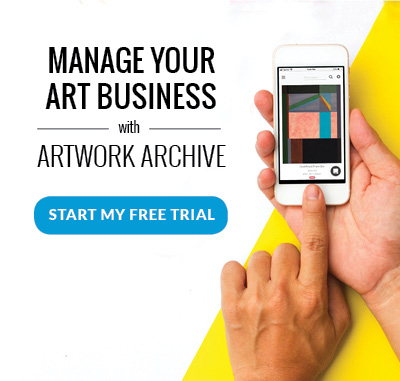It’s time to rethink the phrase “going corporate.”
Why? Because the corporate art market offers immense opportunities for entrepreneurial artists. It's always a good idea to explore different avenues for sharing your work and to diversify your income streams as an artist.
Have you considered tapping into the corporate market yet?
By tapping into it, you can potentially secure a reliable source of income while also expanding your reach as an artist. It's a chance to connect with new people, build relationships, and create a name for yourself in a different realm.
But, how do you approach businesses, especially large corporations, and pitch your artwork to them? The thought of it can be extremely daunting.
It doesn’t have to be. Here’s a breakdown of how to approach and sell your art to organizations.
Why Consider the Corporate Market?
Having your art in a boardroom, waiting room, or hotel lobby where people are coming and going is a good way to gain exposure to new audiences. These people may not attend a local gallery opening, but while they are stuck in a meeting or waiting for a client, your piece could catch their eye.
Companies also benefit from having fine art as a talking piece and showcasing their support for the arts. Businesses thrive and enrich their communities when they make connections with the local art market.
What's the first step?
A common misconception about the corporate art market is that you need to be selling to Fortune 500 companies. But, start locally!
Look around your city and take note of which institutions display art collections. Find the decision-maker and get their contact information.
Depending on the size of the organization, you’ll likely be put in touch with either the owner or curator. Craft a concise, professional pitch introducing yourself and your artwork. Many establishments like to feature local artists, so don’t hesitate to send that introductory email.
One word of caution—approach these transactions from a business-to-business standpoint. It may be tempting but don’t accept any deals or trades that aren’t commensurate with the value of your work.
Build a Professional Portfolio
If you’re working directly with a business, showing them that you have a professional approach to sales is essential. This will reassure them that your artwork will be delivered as expected, as well as prevent them from trying to take advantage of you.
Creating a polished portfolio showcasing a variety of your best works is a sure-fire way to show off your professionalism.
Make sure you include high-quality images of each piece along with clear descriptions and any other details that may be relevant to your artwork.
You also want to be able to access this portfolio at any time—so you can share it when you're talking with potential corporate clients.
Access Your Portfolio on the Cloud
To keep your portfolio well-organized, secure, and accessible, use an inventory management system like Artwork Archive.
Artwork Archive's Public Profile feature allows you to create and share a clean, polished, highly professional online portfolio—complete with relevant artwork details that you can access on any device.
Develop a Strong Online Presence
Before you approach a prospective corporate client, make sure your website is up to date and that your inventory is current. It's also a good idea to stay active and engaged on your social media profiles.
Then, go where the corporates go...
Consider using a platform like LinkedIn to connect with business professionals in your area. It's a good way to expand your network while scoping out possible clients. Make sure your own profile highlights your artwork and it's easy to get in touch with you!
Network Extensively
Attend industry events, art fairs, and business network meetings. Be ready to talk about your artwork—and do so with confidence. As always, keep business cards and samples of your artwork handy (ahem, remember you can pull up your Public Profile on Artwork Archive from anywhere).
Follow-up is key!
Save the contact information of important corporate players you connect with in your Artwork Archive account so you can send them a personalized follow-up message later.
Keep Your Artist Network in One Place
Artwork Archive's powerful CRM feature allows you to keep track of important information about your artist network—including where and how you met them.
Create Contact Groups to sort your corporate clients from the rest of your artist network, and tailor your communications so you can offer a personalized touch.
You can also view the history of reports shared with a client, helping you keep track of whom you've already sent inventory lists of available work to.
Find the Perfect Corporate Match for Your Artwork
The art hanging in a pediatrician's office is likely pretty different than what you'd find at a local boutique or clothing store. When scoping out prospective customers, think about which aesthetic matches your art. Then, decide which companies best fit your style and vision as an artist.
“When approaching corporations and corporate art consultants, you should be prepared with the benefits your art will have on the work environment,” advises The Artrepreneur Coach. She also suggests thinking about how your work will enhance the company’s mission and presenting it to them in that way.
Your audience will also impact your marketing strategy, so try new marketing tactics to see what connects with each particular audience.
Consider Offering Customization and Commissions
Many businesses look for unique, custom artwork that reflects their brand's identity.
While you need to be sure if it's right for your own art practice, offering commissions or customized pieces can be a big draw to certain corporations.
You could also propose the idea of leasing your artwork, which can appeal to companies who are looking to keep their office dynamic or align with seasonal themes.
Think About Soliciting the Help of a Professional
One way to make deals in the corporate art world is by hiring an art consultant. Arts consultants work by connecting collectors, corporations, and artists to find the right piece for a space.
As an artist, working with an art consultant will also help when it comes to ironing out the details of the contract, such as payment, transportation, insurance, and other issues that may come up during the transaction.
Bear in mind that they will take a commission as payment for this involvement.
Professionalism is Key
Businesses (as with any client) often need to see extensive details about pieces, including size, availability, and cost breakdowns for originals and prints before they buy from you.
Have a system in place for your art business.
Using an inventory management system like Artwork Archive makes this step a lot easier and helps make sure you come to the table prepared with all the information needed to make a purchase.
The art business experts at ArtsyShark suggest that you anticipate additional questions and have the answers at your fingertips. Questions about maintenance, hanging, or custom alterations should be priced out and given the forethought to avoid holding up a sale.
Start Sooner Than Later
Landing corporate deals can take some time to gain momentum, but the payoff is worth the effort—so start today.
Begin by scoping out prospective corporations or business professionals, building out your contact list, setting reminders, and organizing your inventory. Artwork Archive offers comprehensive tools for every part of a sale from first contact and communication to negotiating and closing the deal.








